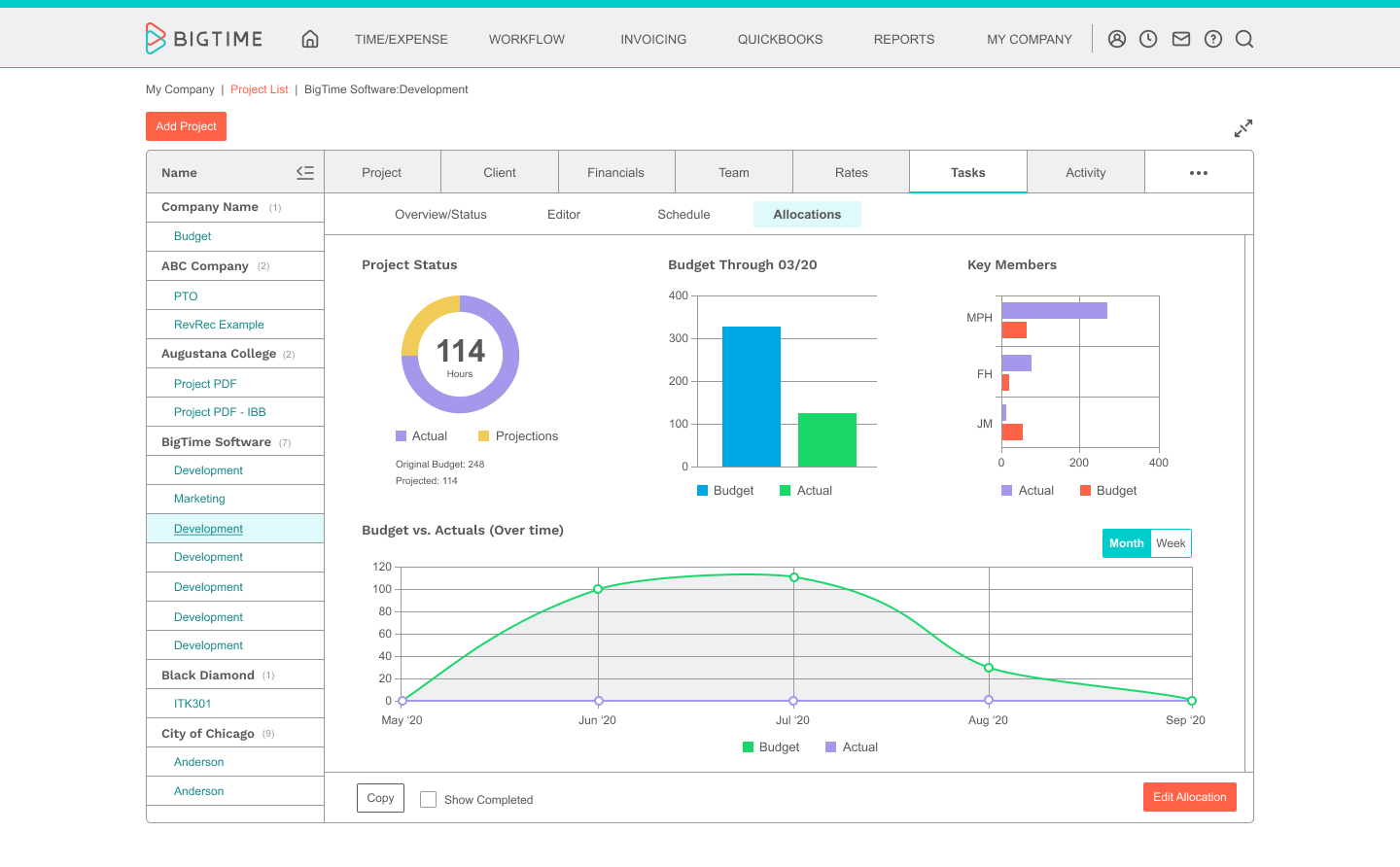Resource Allocation Meaning
Develop a complete understanding of your firm's staff capacity on projects with resource allocation software.
SHOW ME HOW
Track smarter, not harder
Easily log time and expenses with personalized data entry options for your team's individual timesheets.
Bill fast and friendly
Quickly pull together professional-looking custom invoices and send to your clients without the hassle.
Avoid over/under scheduling
Always have an idea of you who working on what and reduce overall time on the bench.
Keep projects moving
Smoothly handoff work between teams and approval levels with custom workflows so you can manage your projects you way.
Plan ahead and on the fly
See your plans and analyze progress at a glance with dashboards, analytics, and reporting.
Connect your favorite tools
Seamlessly sync your current software with our deep integrations and full tech support from our team.
Better growth starts here.
LEARN MORE
Resource allocation is the collection of processes involved in distributing a firm’s resources among team members and across the various competing activities. Resource allocation ensures that every company’s operation goals are achieved and stellar. Resources, as used here, refer to the factors necessary for production and service rendering. Examples include workforce, time, equipment, and budget.
The art of scheduling resources is becoming increasingly essential as service delivery firms’ and companies’ shortcomings constantly involve being timely with deliverables, clearing up schedules for newer work, and ensuring consistent employee productivity. Resource allocation clears these challenges by simplifying and evaluating client goals, team member strengths, and task urgency. Project managers act on the information provided by resource management tools to design a work schedule that fits every team member.
Understanding the principles guiding effective resource allocation sets an organization on the right path for long-term client retention and acquisition success. How? The availability of any service delivery business impacts customers’ loyalty, impacting sales. 65% of companies’ business comes from existing customers, and 56% of customers are more likely to stay loyal to brands that deliver the best job.
A 2019 Project Management Institute survey shows that tasks completed using project management software are consistently satisfactory, timely and within budget compared to jobs without adequate resource management. However, despite these numbers, only 23% of companies utilize resource allocation tools.
Businesses may manually assign jobs to employees instead of using paid project management tools to save costs. But this solves nothing because one of the key problems in resource allocation in strategic management remains unsolved. Unrealistic demands, inaccuracies in data entry, and the lack of transparency between teams can set companies several steps back. This article will cover the benefits of simplifying your business workflow by using and investing in resource allocation software.
Resource Allocation Example
Resource allocation software like BigTime is integral to service companies with employees on an hourly payroll. Understandably, the manual entry of work hours made by employees can be tiring and bore the project manager, and also consumes time that would have been channeled towards more productive activities. The project manager’s interaction with the tool kickstarts and accelerates an organization’s workflow efficiency.
Clients’ goals differ, and so do their budgets, even if the job description is similar, not to mention the urgency of these goals. It is the project manager’s responsibility to timely achieve the set goal of each project and stay within budget.
To employ the appropriate resource allocation strategy, project managers must begin by understanding the firm’s utilization reports. A utilization report documents the efficiency of an organization within a specified period, with possible influencing factors considered. That way, the resource allocation strategy can be altered to manage resources and specific goals effectively.
Here’s a resource allocation example in project management. A departmental head is asked by his bosses to improve the profit margin for the first quarter of the year; how would he go about it? The solution can be to lower the expenses per project, charge higher, improve the department’s efficiency or do all three, depending on the firm’s shortcomings.
Lowering the expense for each project may mean ensuring that employees do not waste their workable hours by active and real-time monitoring of tasks. The organization can take more jobs and clients into their schedule without negatively impacting productivity by reducing weekly planning meetings and time spent matching workers to duties.
Features that make this possible are:
- Skills match to find the best-suited worker for the task
- Allocation dashboard to assign tasks and time for completion
- Utilization dashboard, providing insights on what aspects can be improved
Types of Resource Allocation
There is no one-solution-fits-all approach to tackling problems arising from the inefficient management of firms’ resources. Every cause of inefficient resource utilization requires a unique resource allocation strategy. Sometimes, streamlining the organization’s workflow according to the resource allocation best practices prevents management problems from occurring.
There are two primary types of resource allocation in project management that can be used to ensure resources are used efficiently.
Critical Path Method
The critical path method (CPM) begins with accepting that the project’s success depends on the several tasks that make it complete. The most number of activities required for a job’s completion is its critical path, and the flexibility of scheduling such tasks is considered for timely execution.
With CPM, several task possibilities are drawn to determine the quickest and latest times the project can be completed. Tasks that do not contribute to a project’s successful execution are considered redundant. This eliminates the time and resources wasted on non-productive activities. There is, however, one drawback concerning this technique; CPM is not suitable for multitasking.
Critical Chain Method
The critical chain method (CCM) prioritizes the smaller tasks needed for the successful completion of a project. CCM is designed to monitor how resources are utilized and change the delivery schedule of firms. While CCM may be an offshoot of CPM, CCM is the most suitable methodology for managing projects and allocating scarce resources because timing contingency is a central feature. The CCM project delivery date has a buffer time included to account for any unforeseen delays in the prompt execution of the project. If there is a delay, it is the project manager’s responsibility to develop ways to cover up for the pushback and ensure that the due date is met.
Resource Leveling and Resource Smoothing
Resource leveling and resource smoothing are two resource allocation theories that improve on the critical path and critical chain methods. They account for the potential dynamism of plans required for successful project execution.
Resource leveling modifies project delivery dates according to the resources available. The method resolves problems regarding excess resource allocation to activities and protects workers’ productivity levels.
Resource leveling differs from resource smoothing based on what is prioritized. Resource smoothing is advised if the primary hindrance to completing the project is time. In contrast, resource leveling is proper when the needed resource is limited. Resource leveling and resource smoothing are utilized as a pair; the former is used at the beginning, while the latter is used at the end of resource-leveling.
What is Resource Allocation in Project Management?
The importance of resource allocation theory in project management cannot be overstated. Before the emergence of resource management software, project managers had to rely on spreadsheets to allot tasks to workers. Using Excel as the predominant tool for resource allocation in project management does not guarantee the same level of sophistication as tools specific for the purpose, like BigTime.
Corporations and big companies are often at a disadvantage in communication due to the silo mentality adopted by teams and departments. Project management software is typically cloud-based, encouraging collaboration between teams and eliminating time lag between information demand and response time as well as improving the allocation of scarce resources. With a spreadsheet, employees can lay claims to false workable hours due to the absence of monitoring. This leads to more resources in the budget spent because actual productivity cannot be accurately measured.
BigTime is compatible with all types of resource allocation in project management, making it very popular among project managers. Non-profit and for-profit organizations have different styles of financial reporting, and only project management-specific tools can get it done within a short time.
Importance of Resource Allocation in Project Management
Corporations experiencing difficulties in resource allocation in strategic management are capable of jeopardizing their future. These difficulties may include but are not limited to:
- Poor employee productivity resulting from a worker-task mismatch
- Persistent customer dissatisfaction due to not meeting the project goals
- Inconsistent financial analytical results and reporting styles
- Poor communication between teams
With these problems, it is clear that the successful daily running of a company hinges significantly on the ability of the firm’s project manager to manage resources by projects, skilled workers and the goals and urgency of the project. Here are four benefits of resource allocation:
Understanding the Availability of Organizational Resources
The resources required to complete projects can have little to no variations. However, it is helpful for the project managers to take inventory of resources available for effective redistribution across teams and activities. This helps project managers determine the resource allocation, meaning the availability of their firms to work on projects and assess if they can deliver before the deadline day.
Better Control of Organizational Output
If the appropriate strategies are used as a company’s resource problems demand, project heads will be more in control of the results. They are able to find out what possible routes to project completion is best for that stage of the firm’s growth and what tasks to prioritize. With careful and diligent allocation and planning of resources, the possibility of unforeseen circumstances is narrowed.
Improved Growth Projection and Communication Channels
Resource management tools make it easier for companies to make accurate financial projections. It makes it easier to understand the market trend and if resources may be scarcer around at any point in time. While a solid resource allocation definition enables companies to become future-proof, reputable project resource management software help teams communicate better and share information better. As a result, the meeting times and expenses are reduced.
Contact BigTime Today To Improve Your Firm’s Resource Utilization
Using spreadsheets and other methods that require manually entering data for resource allocation does not cut it anymore, especially for businesses serious about scaling. BigTime is essential for project managers who wish to save time and money through accurate and automated resource tracking. Our team will work with you to boost organizational resource management and workflow efficiency. Request a demo to learn more today!



